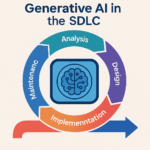Introduction: What’s Changing in SDLC and Why It Matters
For decades, the Software Development Life Cycle (SDLC) has been the backbone of software creation, guiding teams through a structured process of ideation, design, implementation, testing, deployment, and maintenance. While this framework has evolved gradually with agile and DevOps practices, a seismic shift is now underway. The catalyst? Generative Artificial Intelligence (AI). This revolutionary technology is redefining how software is imagined, built, and delivered making processes faster, smarter, and more scalable.
The need for speed, quality, and innovation in software development has never been greater. As user demands grow and systems become increasingly complex, companies are looking for tools that enable higher productivity without compromising quality. Generative AI emerges as the answer augmenting human capabilities, eliminating repetitive tasks, and offering predictive insights that traditional methods simply can’t deliver.
As we dive deeper, we’ll explore how Generative AI in SDLC is transforming each stage of development. From intelligent code generation to automated testing and smarter project planning, the future of software lies in the symbiotic relationship between humans and AI.
AI-Powered Testing: The Backbone of Quality with Generative AI in software testing
Software testing has always been one of the most time-consuming and error-prone stages in SDLC. Manual testing not only delays delivery timelines but also misses edge cases, especially under tight release cycles. Enter Generative AI in software testing, which introduces unparalleled efficiency and accuracy into quality assurance.
This approach automates the generation of test scripts based on code analysis, user behaviour, and historical data. It can simulate thousands of test scenarios in seconds, significantly reducing time-to-market and bug rates. AI doesn’t just detect bugs it predicts them, guiding developers to improve code before it goes live.
For instance, V2Soft’s newly launched SANCITI AI leverages generative AI models to conduct regression tests and identify anomalies early. Businesses using this platform have reported up to 40% reduction in QA costs and 50% faster release cycles. In an age where application stability and performance are critical, such tools offer a transformative edge.
From Planning to Deployment: Real Benefits of using AI in SDLC
The advantages of AI go far beyond testing. The full spectrum of Benefits of using AI in SDLC includes enhancements in planning, risk prediction, project estimation, and resource allocation. These improvements streamline the entire development process, reducing rework, avoiding scope creep, and maximizing team efficiency.
AI tools can analyse user stories, past project data, and team performance metrics to recommend realistic sprint goals. They can even auto-prioritize features based on business value and risk. Project managers benefit from predictive dashboards that provide early warnings about potential delays or budget overruns.
From a developer’s perspective, AI-powered code suggestions increase productivity, while integration with CI/CD pipelines ensures smooth, automated deployments. Global companies like IBM and SAP have begun to embed AI across their SDLCs, reporting major cost savings and cycle reductions. Clearly, the strategic Benefits of using AI in SDLC position organizations for long-term agility and success.
Global View: Comparing India and the US in sdlc gen ai Adoption
When it comes to sdlc gen ai, both India and the United States are leading but in unique ways. The US has historically led innovation in AI research and enterprise adoption. However, India’s momentum in implementation, talent availability, and cost-efficiency gives it a competitive advantage in scalable adoption.
A 2024 industry report revealed that while 72% of US tech firms have adopted some form of AI in SDLC, Indian firms are catching up with a 25% annual growth rate in adoption. Companies like Infosys, TCS, and V2Soft are developing in-house AI capabilities, while mid-sized startups leverage cloud AI platforms to modernize their development pipelines.
India’s strength lies in volume and scalability. With a lower cost base and a huge developer workforce, Indian firms are rolling out AI-enabled SDLC solutions faster than ever. Platforms like SANCITI AI are enabling India to serve not just domestic needs but global clients, often at a fraction of US costs. This cost-efficiency positions India as a key AI hub in the global software economy.
Smarter Automation with sdlc ai in Agile and DevOps Environments
The use of sdlc ai in Agile and DevOps environments is growing rapidly due to the need for rapid iterations and continuous delivery. Traditional tools often struggle to keep up with such demands. Generative AI, on the other hand, enables real-time insights, continuous testing, intelligent coding assistants, and automated documentation.
AI helps development teams by automating routine tasks like setting up environments, creating test data, and managing logs so developers can focus on solving business problems. In CI/CD workflows, AI ensures faster merges, detects integration issues earlier, and helps maintain version control with minimal manual oversight.
V2Soft’s SANCITI AI is a prime example of this, as it allows for AI-led sprint retrospectives, feedback loops, and backlog refinement using predictive analytics. Businesses adopting sdlc ai have seen code deployment times drop by over 45% and overall team productivity increase by 30%. Such results prove that AI isn’t just a tool it’s becoming the operational core of modern software teams.
Looking Ahead: Forecasting the Future of Generative AI in SDLC Globally
As adoption increases, the future of Generative AI in SDLC looks incredibly promising. From design to maintenance, every phase is becoming smarter, faster, and more interconnected. The focus is shifting from isolated automation tools to end-to-end intelligent SDLC ecosystems powered by generative AI.
Market forecasts suggest that AI in SDLC will grow at a CAGR of 18.5% globally through 2030. India is expected to exceed this with a CAGR of 25.8%, thanks to government support and growing private-sector investment. This momentum will enable India to develop global SDLC solutions that compete with or even surpass those in the US and Europe.
Historic data backs this up. Companies that implemented generative AI in their SDLCs between 2019 and 2024 saw an average 30% improvement in delivery speed and a 40% drop in post-release incidents. In the next few years, expect AI to also handle compliance, security risk assessment, and even ethical code review ushering in a new era of intelligent, accountable development.
Conclusion: Generative AI in SDLC Is Not the Future It’s the Now
From intelligent planning to automated testing and deployment, generative AI is fundamentally reshaping SDLC. It’s not just about efficiency; it’s about innovation, collaboration, and long-term sustainability. Countries like India are leveraging their talent pool and cost advantage to adopt AI at scale, while global companies like V2Soft are providing the tools needed to compete.
Organizations that embrace generative AI early are already seeing tangible benefits faster delivery, fewer bugs, lower costs, and happier teams. As we look to the next phase of digital transformation, integrating AI into every layer of software development is not just a trend; it’s a necessity.
Call to Action
Have Questions? Ask Us Directly!
Want to explore more and transform your business?
Send your queries to:
vtusoftbglr@gmail.com / info@v2soft.com






